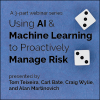Strategic advice to leverage new technologies
Technology is at the heart of nearly every enterprise, enabling new business models and strategies, and serving as the catalyst to industry convergence. Leveraging the right technology can improve business outcomes, providing intelligence and insights that help you make more informed and accurate decisions. From finding patterns in data through data science, to curating relevant insights with data analytics, to the predictive abilities and innumerable applications of AI, to solving challenging business problems with ML, NLP, and knowledge graphs, technology has brought decision-making to a more intelligent level. Keep pace with the technology trends, opportunities, applications, and real-world use cases that will move your organization closer to its transformation and business goals.
Recently Published
The Flywheel: Your Digital Shift Foundation
The COVID-19 outbreak is impacting all businesses globally. It’s impacting staff, contractors, and staffing levels; it’s impacting the supply chain; and it’s impacting processes. Despite companies having crisis management and business continuity plans, current decision-making tools and dashboards are not adequate for dealing with COVID-19-related decision-making given the geographic scale of the disruption. Established risk management methodologies and approaches tend to be static in nature and lead to models that are backward-looking.
























